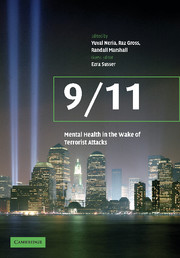Book contents
- Frontmatter
- Contents
- Acknowledgments
- Editors brief bio
- List of contributors
- Foreword
- Part I Introduction
- Part II The psychological aftermath of 9/11
- 2 Preface
- 3 Post-traumatic stress symptoms in the general population after a disaster: implications for public health
- 4 Coping with a national trauma: a nationwide longitudinal study of responses to the terrorist attacks of September 11
- 5 An epidemiological response to disaster: the post-9/11 psychological needs assessment of New York City public school students
- 6 Historical perspective and future directions in research on psychiatric consequences of terrorism and other disasters
- 7 Capturing the impact of large-scale events through epidemiological research
- 8 Mental health research in the aftermath of disasters: using the right methods to ask the right questions
- Part III Reducing the burden: community response and community recovery
- Part IV Outreach and intervention in the wake of terrorist attacks
- Part IV A New York area
- Part IV B Washington, DC
- Part IV C Prolonged-exposure treatment as a core resource for clinicians in the community: dissemination of trauma knowledge post-disaster
- Part V Disasters and mental health: perspectives on response and preparedness
- Index
3 - Post-traumatic stress symptoms in the general population after a disaster: implications for public health
from Part II - The psychological aftermath of 9/11
Published online by Cambridge University Press: 27 October 2009
- Frontmatter
- Contents
- Acknowledgments
- Editors brief bio
- List of contributors
- Foreword
- Part I Introduction
- Part II The psychological aftermath of 9/11
- 2 Preface
- 3 Post-traumatic stress symptoms in the general population after a disaster: implications for public health
- 4 Coping with a national trauma: a nationwide longitudinal study of responses to the terrorist attacks of September 11
- 5 An epidemiological response to disaster: the post-9/11 psychological needs assessment of New York City public school students
- 6 Historical perspective and future directions in research on psychiatric consequences of terrorism and other disasters
- 7 Capturing the impact of large-scale events through epidemiological research
- 8 Mental health research in the aftermath of disasters: using the right methods to ask the right questions
- Part III Reducing the burden: community response and community recovery
- Part IV Outreach and intervention in the wake of terrorist attacks
- Part IV A New York area
- Part IV B Washington, DC
- Part IV C Prolonged-exposure treatment as a core resource for clinicians in the community: dissemination of trauma knowledge post-disaster
- Part V Disasters and mental health: perspectives on response and preparedness
- Index
Summary
Introduction
Post-traumatic stress after disasters and after September 11, 2001
Major disasters are associated with increased rates of psychological distress and morbidity among survivors (Norris et al., 2002a, b; Galea et al., 2005). The vast majority of post-disaster research has focused on the groups that are typically considered to be most affected by disasters and a substantial literature has documented the burden of psychopathology faced by survivors of disasters (North et al., 1999; Salcioglu et al., 2003) persons who are involved in the post-disaster recovery efforts (North et al., 2002), and family and friends of persons who are killed or seriously injured in disasters (Stoppelbein & Greening, 2000). Post-traumatic stress disorder (PTSD) is the most commonly studied, and likely the most prevalent mental health problem in these groups after disasters (Green & Lindy, 1994; Galea et al., 2005), although other mental health problems including depression (Kuo et al., 2003), generalized anxiety disorder (Smith et al., 1990), and non-specific psychological stress (Carr et al., 1997) have been studied.
In the aftermath of the September 11 attacks there was every reason to believe that the impact of the attacks among the survivors of the attacks would be comparable to that among survivors of other major disasters. For example, in the aftermath of the bombing of the Murrah Federal Building in Oklahoma City, North and colleagues reported that 34.3% of adult survivors of the bombing who were either in the building at the time of the bombing or in close proximity had symptoms consistent with a diagnosis of PTSD in the first 6 months after the bombing (North et al., 1999). Official estimates of the number of persons who were survivors of the September 11 attacks vary.
- Type
- Chapter
- Information
- 9/11: Mental Health in the Wake of Terrorist Attacks , pp. 19 - 44Publisher: Cambridge University PressPrint publication year: 2006
- 5
- Cited by

